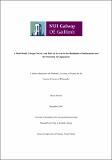| dc.contributor.advisor | Pandit, Abhay | |
| dc.contributor.author | Shane, Browne | |
| dc.date.accessioned | 2015-04-17T12:07:33Z | |
| dc.date.issued | 2014-12-15 | |
| dc.identifier.uri | http://hdl.handle.net/10379/4927 | |
| dc.description.abstract | Tissue engineered organs and implants hold promise for the replacement of damaged and diseased organs. However, the foreign body response (FBR) is a major obstacle that compromises the function of tissue engineered constructs, typically causing them to fail. Two components of the FBR are the inflammatory response and a lack of vascularization. To overcome these, this project has delivered anti-inflammatory and pro-angiogenic nucleic acids. A collagen system was developed to release interleukin-6 (IL-6) siRNA and endothelial nitric oxide synthase (eNOS) pDNA in a staggered manner. Collagen hollow microspheres were fabricated using a template-method and displayed an ability to load and release pDNA, maintaining the capability to transfect 3T3 fibroblasts in vitro, while reducing vector-associated toxicity. Following the identification of an optimal microsphere size, hollow collagen microspheres were assembled into a collagen sphere-in-hydrogel system that displayed a staggered release profile in vitro This system was assessed in vivo in a subcutaneous rat model. The doses of IL-6 siRNA and eNOS pDNA were first individually optimized for their ability to reduce the volume fraction of inflammatory cells (7 days) and increase the length density of blood vessels (14 days), respectively. The identified optimal doses were combined and the ability of the system to decrease the volume fraction of inflammatory cells and increase the length density of blood vessels was confirmed at both 7 and 14 days. Analysis of the tissue using Raman spectroscopy revealed that in addition to changes in inflammation and angiogenesis, there were also changes in the extracellular matrix (ECM) of the tissue at seven days. While changes in sulfated glycosaminoglycans (sGAG) content of the ECM were not detected, changes in the binding of sGAG of the ECM to growth factors was observed. Two growth factors tested, VEGF165 and bFGF showed increased binding to sGAG extracted from eNOS pDNA treated samples at seven days, increasing the angiogenic potential of the ECM. Overall, the system shows promise for the treatment of pathologies in which inflammation and angiogenesis are dysregulated. | en_US |
| dc.rights | Attribution-NonCommercial-NoDerivs 3.0 Ireland | |
| dc.rights.uri | https://creativecommons.org/licenses/by-nc-nd/3.0/ie/ | |
| dc.subject | Biomaterials | en_US |
| dc.subject | Gene delivery | en_US |
| dc.subject | Inflammation | en_US |
| dc.subject | Angiogenesis | en_US |
| dc.subject | Extracellular matrix | en_US |
| dc.title | A multi-modal collagen nucleic acid delivery system for the modulation of inflammation and promotion of angiogenesis | en_US |
| dc.type | Thesis | en_US |
| dc.contributor.funder | Science Foundation Ireland | en_US |
| dc.local.note | The failure of biomaterial implants can be attributed to the host inflammatory response and a lack of vascularisation following implantation. Biomaterial system capable of reducing the inflammatory response and increasing blood vessel formation via the delivery of nucleic acids is a major step towards increasing the success of biomaterial implants. | en_US |
| dc.description.embargo | 2016-02-13 | |
| dc.local.final | Yes | en_US |
| nui.item.downloads | 199 | |


